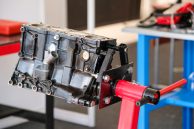We hope you love the products we recommend and just so you know that as an Amazon Associate EngineHoist.net may earn from qualifying purchases.
Are you wondering, “Can you run an engine on an engine stand?”
The answer is yes!
Running an engine on an engine stand can be a great way to test and troubleshoot before installing it in a vehicle. In this article, we’ll discuss everything you need to know about safely running an engine on an engine stand and the benefits it can provide.
Why Run an Engine on an Engine Stand?
Running an engine on an engine stand can be helpful for a variety of reasons:
- Diagnosing and troubleshooting issues before installation
- Performing break-in procedures on a newly rebuilt engine
- Tuning and making adjustments in a controlled environment
- Verifying the overall condition of a used engine before investing in further repairs
Essential Components for Running an Engine on an Engine Stand
To successfully run an engine on an engine stand, you’ll need a few essential components:
- Fuel supply: An external fuel source or a small fuel container connected to the engine’s fuel system.
- Ignition system: Ensure the distributor, spark plugs, and ignition wires are properly connected.
- Battery and cables: A car battery and cables to power the starter motor and ignition system.
- Starter motor: A trigger starter or a screwdriver to short the solenoid S terminal to the battery terminal.
- Cooling system: Although a radiator is ideal, a jug of coolant can also be used for short periods of testing.
- Exhaust system: Headers or manifolds to safely expel exhaust gases.
- Gauges: Oil pressure and temperature gauges to monitor the engine’s vital signs.
Running the Engine on an Engine Stand: Safety Precautions
Running an engine on an engine stand does come with some risks, so it’s crucial to take safety precautions:
- Use a fire extinguisher: Always keep a fire extinguisher nearby in case of fuel leaks or other fire hazards.
- Secure the engine: Make sure the engine is securely mounted on the stand and well-supported to prevent tipping or falling.
- Check for leaks: Inspect all hoses, connections, and seals for leaks before starting the engine.
- Monitor temperature and pressure: Keep a close eye on the engine’s temperature and oil pressure to avoid overheating or damaging the engine.
Performing a Compression Test on an Engine Stand
A compression test is an essential diagnostic tool that can be performed on an engine while it’s on an engine stand. This test can help you assess the overall condition of the engine by measuring the cylinder pressure.
To perform a compression test on an engine stand:
- Remove all spark plugs.
- Install a compression tester into the spark plug hole of the first cylinder.
- Crank the engine for a few seconds using the starter motor.
- Record the compression reading on the gauge.
- Repeat the process for all cylinders.
- Compare the readings to the manufacturer’s specifications to determine the engine’s condition.
Conclusion
So, can you run an engine on an engine stand? Absolutely! With the right components and safety precautions, running an engine on an engine stand can be an invaluable tool for testing, troubleshooting, and tuning. By following the guidelines provided in this article, you’ll be well on your way to successfully running your engine on an engine stand.










